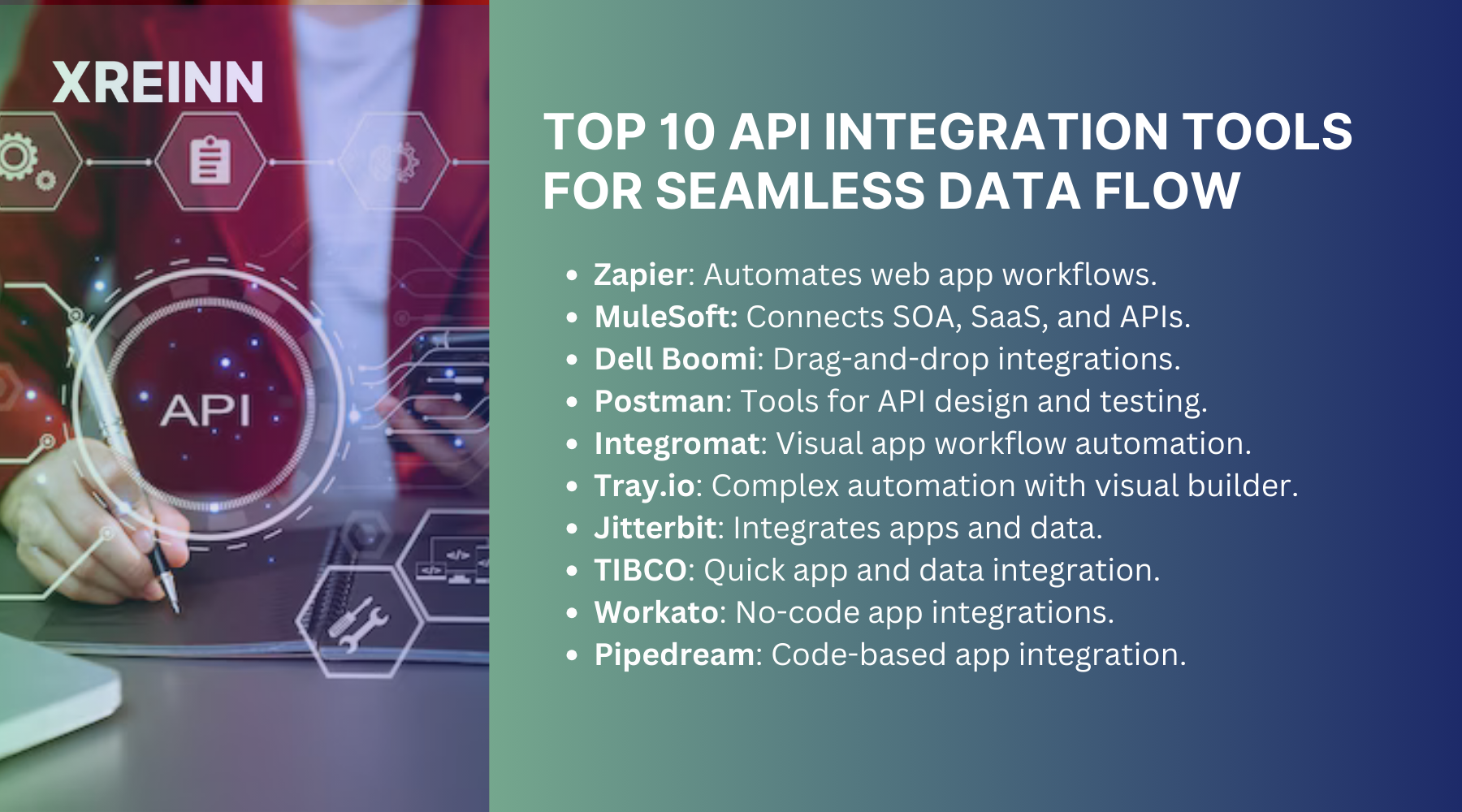Data Integration
Top 10 API Integration Tools for Seamless Data Flow
Aug 01, 2024
Advanced API integration tools are the foundation of smooth communication between systems. These tools enable systems to work in harmony and optimize workflows. Choosing the right tools is significant for improving functionality and efficiency, as they reduce manual intervention and minimize errors, ensuring smooth data flow across platforms.
Moreover, they empower you to build more scalable and powerful applications, accommodating future growth and technological advancements.
In this article, we will discuss the top 10 API integration tools that can transform your approach todata integration.
What is API Integration?
API integration is the process of connecting two or more applications via their Application Programming Interfaces (APIs) to enable data exchange and functionality sharing. It allows disparate systems to communicate, ensuring that data flows seamlessly between them. For advanced users, understanding the intricacies of API integration goes beyond knowing what it is; it involves mastering how these integrations work, how to implement them efficiently, and how to troubleshoot potential issues.
Benefits of an API Integration Tool
1. Improved Efficiency
API integration tools automate data exchange between systems, significantly reducing manual effort and minimizing errors. This leads to time savings and allows teams to focus on more strategic tasks, improving overall productivity.
2. Improved Data Accuracy
By automating data transfer, API integration tools ensure more accurate and reliable data by minimizing the risk of human error. This is particularly important in sectors like healthcare and finance, where data integrity is crucial.
3. Cost Savings
Automating routine tasks with API integration tools leads to substantial cost savings by reducing the need for manual data entry and lowering operational expenses. Businesses can reallocate resources to more value-added activities.
4. Scalability
API integration tools enable businesses to scale operations efficiently. As the business grows, these tools handle increasing volumes of data and transactions seamlessly, without requiring a proportional increase in manual labor.
5. Real-Time Data Access
With API integration tools, businesses can access real-time data, leading to more informed decision-making and quicker responses to market changes. This is essential for staying competitive and adapting to dynamic business environments.
Top 10 API Integration Tools for Seamless Data Flow

1. Zapier
Zapier connects your apps and automates workflows, enabling data to move seamlessly between your web apps.
How it works: Zapier operates on a trigger-action model. When an event happens in one app (the trigger), Zapier automatically performs a specific action in another app. You can create "Zaps" without writing any code, making it easy to automate repetitive tasks.
2. MuleSoft Anypoint Platform
MuleSoft Anypoint Platform provides a unified, flexible integration platform that solves the most challenging connectivity problems across SOA, SaaS, and APIs.
How it works: MuleSoft Anypoint Platform uses Mule, an integration engine, to connect different applications, data sources, and APIs. Developers can design, deploy, and manage APIs and integrations using a visual interface or through code, making it versatile for various integration needs.
3. Dell Boomi
Dell Boomiis a cloud-based integration platform that connects applications and data seamlessly.
How it works: Dell Boomi uses a visual interface where you can drag and drop components to create integration workflows. It supports a wide range of connectors and uses Boomi Atoms to execute integrations, which can run in the cloud or on-premises.
4. Postman
Postmansimplifies API development by enabling developers to design, mock, debug, test, document, monitor, and publish APIs from a single platform.
How it works: Postman offers a comprehensive suite of tools for API development. You can create and send HTTP requests, inspect responses, and automate testing. Collections allow you to group related requests, making it easy to manage and share APIs.
5. Integromat (Make)
Integromat automates workflows by connecting apps and services and transferring data between them automatically.
How it works: Integromat uses scenarios to automate workflows. You create scenarios by linking different modules, which represent the actions and data transfers between apps. The visual interface allows you to set conditions and logic, providing flexibility in automation.
6. Tray.io
Tray.io offers a powerful, flexible platform for automating complex workflows and integrating with various apps and services.
How it works: Tray.io’s visual workflow builder lets you design integrations by dragging and dropping components. It supports multi-step workflows and advanced logic, allowing you to handle complex automation tasks with ease.
7. Jitterbit
Jitterbit enables the integration of various applications, systems, and data sources through a unified platform.
How it works: Jitterbit uses its Harmony platform to connect APIs, on-premises systems, and cloud applications. It provides a graphical interface for designing integrations and supports advanced data transformation capabilities to ensure seamless data flow.
8. TIBCO Cloud Integration
TIBCO Cloud Integration provides tools to connect applications and data sources quickly and easily.
How it works: TIBCO Cloud Integration uses pre-built connectors and a visual interface to create integration flows. It supports real-time and batch processing, enabling you to design integrations that meet various business needs efficiently.
9. Workato
Workato integrates apps and automates workflows without requiring any code, making it accessible for both IT and business users.
How it works: Workato’s platform uses a recipe-based approach to automate workflows. Recipes are sets of steps that define how data moves between apps. You can create recipes using a simple drag-and-drop interface, with options for conditional logic and error handling.
10. Pipedream
Pipedreamprovides a platform for connecting APIs, databases, and apps with code, offering flexibility for developers.
How it works: Pipedream lets you write JavaScript code to handle integrations, giving you full control over the process. You can create workflows that run on triggers, connecting to various services and APIs to automate data flow and processing.
Why Do Businesses Need an API Integration Tool?
API integration tools are essential for businesses to streamline operations by automating data flow between different software systems. This automation reduces manual effort and minimizes errors, improving overall operational efficiency and allowing companies to focus on core activities and strategic initiatives.
Moreover, these tools improve data accuracy by ensuring consistent and reliable data transfer, eliminating the errors associated with manual data entry. The cost savings are significant, as automating routine tasks reduces the need for manual labor, enabling businesses to allocate resources more effectively toward growth and innovation.
Additionally, API integration tools offer improved flexibility through customization options, allowing seamless communication between diverse systems and adapting to unique business workflows. Access to real-time data is another critical benefit, enabling businesses to make informed decisions quickly and respond rapidly to market changes, customer demands, and operational needs.
Conclusion
API integration tools are vital for modern businesses to improve operational efficiency and data accuracy. They automate data flows, cutting manual errors and labor costs, which frees up resources for strategic growth. Their flexibility ensures seamless communication across various systems, adapting to different workflows.
With the rapid growth of technology, real-time data access is more important than ever. These tools provide the agility to respond quickly to market changes and customer needs, helping businesses stay competitive and streamline operations in a data-driven world.

Data Analytics
Jun 27, 2024Master key concepts in data analytics with practical tips to enhance decision-making and achieve success in your projects and professional growth

Data Analytics
Jul 01, 2024Learn the essential stages of the data analytics workflow to turn your data into valuable business insights and drive growth.

